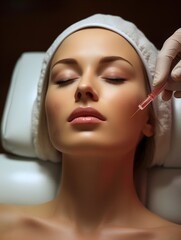Introduction
Injectable treatments have revolutionized the field of cosmetic enhancements, offering a non-surgical solution to address various signs of aging and aesthetic concerns. While Botox is widely known for its wrinkle-smoothing effects, dermal fillers provide additional options for those seeking to rejuvenate their appearance. This article explores the world of Dermal Fillers Injections in Dubai, highlighting their benefits, types, and applications, and helping you understand how they can complement or even surpass traditional Botox treatments.
1. What Are Injectable Dermal Fillers?
Injectable dermal fillers are substances injected into the skin to restore volume, smooth out wrinkles, and enhance facial contours. Unlike Botox, which temporarily paralyzes muscles to reduce the appearance of wrinkles, dermal fillers work by physically filling areas of volume loss and adding contour to the face. They are made from a variety of materials, each offering distinct properties and benefits.
2. Types of Dermal Fillers
Understanding the different types of dermal fillers is essential for choosing the right one for your needs. Here are the most common categories:
- Hyaluronic Acid Fillers: Hyaluronic acid is a naturally occurring substance in the body that attracts and retains moisture. Fillers containing hyaluronic acid are popular for their ability to provide instant volume and hydration, making them ideal for treating fine lines, wrinkles, and lip augmentation.
- Calcium Hydroxylapatite Fillers: This type of filler contains calcium microspheres suspended in a gel. It is used for deeper wrinkles and volume loss, such as in the cheeks and nasolabial folds. Calcium hydroxylapatite also stimulates collagen production, providing long-lasting results.
- Poly-L-Lactic Acid Fillers: Poly-L-lactic acid is a biodegradable synthetic material that stimulates the body’s natural collagen production. This type of filler is used for treating deeper facial wrinkles and volume loss and offers gradual, natural-looking results over time.
- PMMA (Polymethylmethacrylate) Fillers: PMMA fillers consist of tiny microspheres suspended in a collagen gel. They are used for deep wrinkles and volume loss and provide long-lasting effects. PMMA fillers help maintain their shape and support the skin's structure.
3. Benefits of Dermal Fillers
Dermal fillers offer several advantages, including:
- Immediate Results: Many dermal fillers provide instant improvement in volume and smoothness, allowing you to see results immediately after the treatment.
- Minimally Invasive: Dermal fillers are non-surgical, requiring only a few injections to achieve noticeable changes, with minimal downtime and recovery.
- Customizable Treatments: Fillers can be tailored to address specific concerns, such as fine lines, volume loss, or contour irregularities, providing a personalized approach to enhancement.
- Long-Lasting Effects: Depending on the type of filler used, results can last from several months to over a year, making them a cost-effective solution for maintaining a youthful appearance.
4. Applications of Dermal Fillers
Dermal fillers can be used to address a wide range of cosmetic concerns, including:
- Volume Restoration: Fillers are commonly used to restore lost volume in areas such as the cheeks, temples, and under the eyes, providing a more youthful and refreshed look.
- Wrinkle Reduction: They can smooth out wrinkles and fine lines around the mouth, nose, and forehead, helping to reduce the appearance of aging.
- Facial Contouring: Fillers can enhance facial contours, such as defining the jawline and chin, creating a more sculpted and balanced appearance.
- Lip Enhancement: Dermal fillers are popular for adding volume and definition to the lips, achieving a fuller and more youthful lip appearance.
5. Comparing Dermal Fillers and Botox
While Botox and dermal fillers serve different purposes, they can be complementary treatments. Botox works by relaxing the muscles that cause wrinkles, primarily in the forehead and around the eyes. In contrast, dermal fillers address volume loss and enhance facial contours. Combining both treatments can provide comprehensive facial rejuvenation, addressing both dynamic and static wrinkles.
6. Choosing the Right Filler
Selecting the appropriate dermal filler depends on various factors, including your treatment goals, the area to be treated, and your skin type. A consultation with a qualified professional can help determine which filler best suits your needs and ensures that you achieve optimal results.
7. Post-Treatment Care
After receiving dermal fillers, proper aftercare is essential for maintaining results and minimizing side effects. Follow your provider’s instructions, which may include avoiding strenuous activities, sun exposure, and touching the treated areas. Mild swelling or bruising is common but usually resolves within a few days.
8. Managing Expectations
It’s important to have realistic expectations when undergoing dermal filler treatments. While fillers can provide significant improvements, they are not a substitute for surgical procedures and results will vary based on individual factors. Clear communication with your provider about your goals will help ensure that you achieve the best possible outcome.
Conclusion
Injectable dermal fillers offer a versatile and effective solution for enhancing facial features and rejuvenating the appearance. By understanding the different types of fillers, their benefits, and their applications, you can make informed decisions about how to achieve a fresh and youthful look. Whether used alone or in conjunction with Botox, dermal fillers provide a customizable approach to aesthetic enhancement, helping you maintain a vibrant and refreshed appearance.





Comments